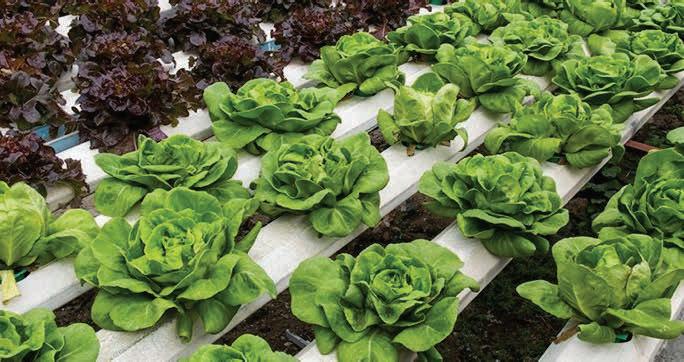
9 minute read
An Explanation of pH Management
Ph is most important in greenhouse farming (Pic: Hannah)
Improper management of media pH commonly results in poor growth and reduced plant quality in greenhouses and nurseries. The pH or soil reaction has a primary influence on the solubility and availability of plant nutrients. Many crops have a narrow range of pH tolerance. If the pH of the soil medium falls above or below this tolerance zone, they may not grow properly due to nutrient deficiency or toxicity. For general greenhouse production a pH of 6.2-6.8 is considered ideal for mineral soils, and 5.8-6.2 is recommended for peat or bark media. Of course, this depends upon the crops grown. Poinsettias are tolerant of variable pH, while seed geraniums are very particular, since pH 5.7 or below can result in iron toxicity problems. Except for nitrates, potassium, and total soluble salts, the availability of most fertilizer elements is affected to some extent by the media pH. Calcium and magnesium become more available as the pH increases, but the opposite is true for iron, manganese and phosphorus. A one unit pH drop can increase the solubility of manganese by as much as 100 times and the solubility of iron by as much as 1000 times.
Advertisement
pH explained
The pH measure is a relative concentration of hydrogen ions (H+) to hydroxide ions(OH-). The greater the number of H+ ions in relation to OH- the more acidic the solution becomes. The greater the ratio of OH- ions to H+, the more basic the solution becomes. PH is measured on a scale of 1-14. A pH of 7 indicates that the H+ and OH- ions are in balance. A reading below 7 means that there are more H+ ions and a reading above 7 indicates more OH- ions.
pH H+ OH-
In horticulture we have traditionally used a pH reading to make amendments to our growing media and irrigation water. But while pH is a good indicator of the availability of dissolved fertilizers in the root zone, it is not at all good at predicting the effect that a given irrigation source will have on the media pH. For that, you must also know the buffering capacity or alkalinity of the media and the irrigation source. Alkalinity levels indicate the relative
ability of the media to resist or neutralize the effects of acids. The higher the alkalinity level, the greater the amount of acidification that will be required to produce a desired pH drop.
pH Testing
All commercial horticultural businesses, regardless of size, should have a reliable pH meter. Follow the instructions included to preserve the accuracy and life of your instrument. Solution samples can be read directly, or after a few hours of settling time. Dissolved CO2 in water supplies can cause slightly lower readings until the sample has come to equilibrium with the air. Freshly mixed samples of media should be watered and allowed to stand for 24 hours before a reading is taken to release some of the lime and fertilizers.
The preferred method for testing media pH is to obtain several representative samples of a crop and to measure each separately. Multiple measurements will give greater accuracy in reading, and will show the degree of variability of pH from pot to pot. A saturated media extract or a 1:1 soil to distilled water ratio is fine for measuring pH.
Why add Lime?
Many horticultural soils require the addition of lime to correct pH and to supply calcium and magnesium. Lime directly affects the alkalinity of the soil medium. The amount of lime needed depends upon these factors: the type of lime, the fineness of the lime particles and the pH, acid content, and buffering capacity of the media. Most potting soils today are amended with dolomitic limestone to supply adequate calcium and magnesium and to buffer the acid content of peat, a prime constituent of many potting soils. Other types of limestone include calcium carbonate, which supplies only calcium, and hydrated lime, which reacts very fast, but is not as long lasting. Hydrated lime is seldom used alone since it is very quick acting and short lived. It is sometimes used in emergencies to raise pH after the plants have been potted, or as a partial component of the lime additives. For greenhouse and nursery soils, the calcium carbonate or dolomite lime used should be rated as 65 mesh or better, which means that 65% of the particles are small enough to pass through a 100 mesh screen. This is often called pulverized lime. Calcium sulfate, or gypsum has a neutral effect upon pH and can be used as a calcium source when no pH effect is required. The amount of lime to use depends upon the peat source. If the peat is highly buffered (acidic), then more lime is needed to have the same effect. Perlite, vermiculite and most other aerating materials have little effect on pH, but since their addition decreases the volume of peat, proportionately less lime is needed. For example, if a cubic meter of pure peat required 7 kg. of lime to raise the pH to 6.0, then a 50% peat, 50% perlite mixture would require only half as much.
Alkalinity Testing
If you have regular solution analysis performed you can usually request an alkalinity or bicarbonate test also. Do-it-yourself alkalinity test kits are also available for low cost from scientific companies. The effects of both pH and alkalinity are important to the nutrition and root health of your crops. Understanding these principles will help to take some of the guesswork out of managing media and solution pH.
How to Measure Alkalinity
Unlike pH, alkalinity is a measure of a solution’s ability to neutralize acids. It is the alkalinity level that determines how your irrigation water will influence the pH of the growing media. Most people who are familiar with pH would expect that high pH irrigation water would tend to raise the media pH over time. However, if the water has very low alkalinity, it may not have a significant effect on media pH despite its high initial pH. By contrast, if we used irrigation water with a high alkalinity level, say 200 ppm bicarbonate a greater effect on media pH can be expected. The higher the alkalinity of the irrigation water, the faster the root media pH will change. Rain water sources of irrigation water normally contain little or no bicarbonate. Well water sources often range from 50-150ppm. Although some bicarbonate alkalinity is good, higher levels can be toxic to some plants and in these cases, well water must be mixed with rainwater to bring the bicarbonate into the desired range. If insufficient bicarbonate is available naturally, then

Using a pH meter.


potassium bicarbonate can be added. Both limestone and bicarbonate raise pH by the production of carbonate. Over time, high alkalinity water sources will tend to increase pH, while low alkalinity sources will decrease it, depending on the rate of leaching and fertilization and the nature of the fertilizers used. Growers with very low alkalinity levels have sometimes found it useful to provide a modest background level of bicarbonate of (60-100) ppm. By then adding small additions of acids to achieve the desired pH, they can dose nutrient solutions with sufficient buffering capacity to change or stabilize the pH of the root media.
Changing Media pH
Understanding the relationship of alkalinity to pH makes it easier to change the media pH when needed. Regular pH testing of the root media is necessary to monitor the condition of the root media and to identify the need for amendment. Several factors come into play when attempting pH alterations. Variables that can influence the rate of pH change and the amount of modifying action needed are: soil temperature, root volume, leaching fraction, the buffering capacity of both the soil medium, and the irrigation source. It is always best to catch pH problems early, before drastic steps are needed. When it becomes necessary to raise or lower the pH in the crop, it is wise to start conservatively to avoid overshooting the tolerance range in the other direction. Wild pH swings can be worse than the original problem.
How to Raise pH
Heavy leaching tends to reduce salts and raise pH provided the water pH is higher than the soil. This also will help to remove any pH-related toxic levels of minor elements such as manganese or iron. Hydrated lime has been used to raise pH in existing crops by dissolving 1 kg. per 100 liters fresh water. After leaving the mixture overnight, the clear solution is drenched onto the crop. This method does not work very well with hard water sources.
Potassium bicarbonate dissolved at 1 kg. per 100 liters will add about 600 ppm bicarbonate to water plus 400 ppm potassium. However, it is best not to raise the pH too quickly due to the possibility of ammonia release. Lower rates of bicarbonate (60-180 ppm or 1-3 kg. per 1000 liters) with each watering are effective at raising pH over time.
Lowering pH
Iron sulfate dissolved at 1-4 kg. per 100 liters has been used where pH is too high. The solution should be acidified enough to dissolve all the sulfate. Ammonium sulfate will lower pH slowly but very effectively due to the action of nitrifying bacteria. The crops treated should be ammonium tolerant, the pH should not be less than 6.2, and the temperature should be above 15oC. Fine ground elemental sulfur at 5 g per 15 cm pot or 15 g per 2-3 gallon container is recommended by some sources as a gradual way of bringing down pH. It is the action of certain soil bacteria that create the change, usually in about 10-15 days. Acid additions are the most common method of reducing pH. They work best if used as a regular component of the feed solution to prevent the media from becoming too basic.
Reducing the feed solution to around pH 4, depending on the alkalinity, can be effective for producing a more rapid change, but some nutrients may be tied up. Most growers use a lab analysis or a trial and error method to calculate how much acid to add toa solution to get a desired pH.
Residues
Wherever chemicals are used to raise or lower pH in irrigation water they may leave deposits on leaves, particularly when used in misting systems. Precipitates caused by sulfuric and phosphoric acids are more of a problem than nitric acid, but nitric acid is more hazardous to handle and can elevate EC levels at high injection rates.
By: M Southwood.









